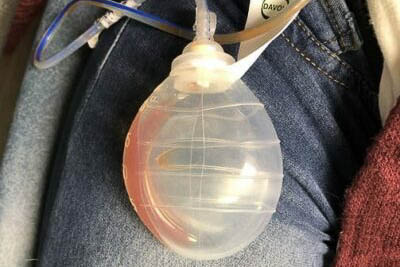
Suction Drains after a Cleft-Lift
Are they really that important?
After a cleft-lift procedure many surgeons place a drain. There are two different basic kinds in popular use.
- One type is a “passive drain” and consists of a flat rubber strip that enters one area and exits another, and allows any fluid buildup to find a way out along the rubber drain and onto the dressing. It requires some occasional rolling pressure along the flap to push fluid out the drain site, and does not allow measurement of the output very precisely.
- The other type is an “active drain”, which is referred to as a “closed suction drain”, or Blake Drain or JP (Jackson Pratt) Drain. It has a clear plastic tube that is placed under the flap, and connects to a clear plastic reservoir, which is emptied once or twice a day and the amount precisely recorded.
I prefer the Blake Drain type because it has been working well for me for many years, but either type is acceptable. However, the bigger questions are whether a drain is really needed at all? And, can failures be attributed to the lack of a drain in cases where one wasn’t used?
The logic of using a closed suction drain is that it:
- prevents any fluid from accumulating under the flap, which could cause a chronic fluid collection (seroma) or infection
- prevents fluid from leaking through the incision, which will weaken the incision and possibly sabotage the success of the operation
- is an indicator of bleeding (the drainage will be red), or infection (the drainage will be creamy) and allows us to respond to the situation more quickly and appropriately.
- pulls the tissues together with negative pressure so they will heal in the position the surgeon intended.
So, what happens if you don’t use a drain? There are no specific studies that compare patients with and without a drain after a cleft-lift, but there are studies that do this with the Karydakis procedure, which is very similar. One study, done in Turkey in 2005, showed that when a drain was not used, 32% of the patients had problems with fluid collections, as compared to 8% in the patients with drains. Another article, from Ireland in 2010 this time, compared using a drain with putting fibrin glue under the flap instead. In this series, there was a 24% complication rate when the drain was not used, vs 6% when it was used.
So, if one can extrapolate the Karydakis data to the cleft-lift, it seems that a drain is useful. But, can you get away without it? Sure: 70-80% of patients would probably do OK without it. The problem is knowing which patients are the ones who are going to have problems. At present, we have no way of prediction this. Afterwards, in patients with low drain output, we might be able to say they could have gotten away without a drain. In those with a large amount of output, that lasts over a week, we can certainly say they benefited from the drain. I use a drain in all patients, because I don’t think a 25-30% rate of problems from fluid is acceptable.
If someone’s cleft-lift failed, and they didn’t have a drain – can we blame it on that omission? It’s hard to say. Often, a poorly constructed cleft-lift goes hand in hand with the omission of a drain. But, without knowing all the details, it is hard to completely blame it on that one issue.
So, I wouldn’t choose your surgeon solely on whether they use a drain, or not. Instead, I would look at how much experience they have, what their interest level is with pilonidal disease, and what their success rates have been. BTW: if you’ve managed to read through this article, you now know more than most surgeons about this topic! Congratulations!
Leave a reply
